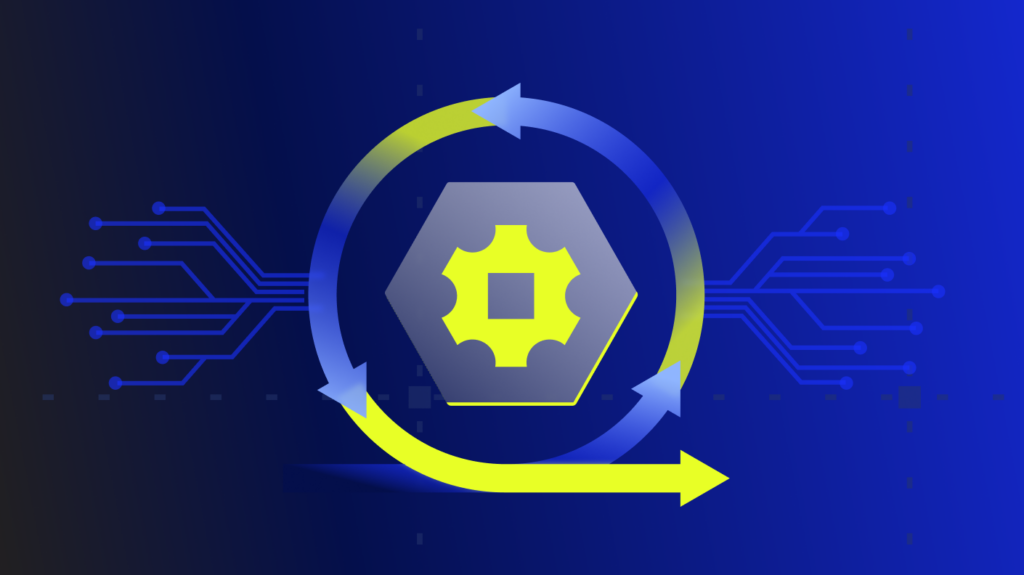Most IT leaders know they need AIOps. Few have a strategy for making it work.
The problem isn’t a lack of AI-powered tools; it’s the absence of a clear, outcome-driven plan. Especially given the rapid adoption of ChatGPT and LLMs in general, organizations are spending billions on AI. But without a defined strategy, AIOps quickly turns into a patchwork of disconnected tools, rising costs, and disappointing ROI.
Of course, slapping “agentic” onto AIOps won’t change that—without a strategy, it’s just more automation without direction. The solution shouldn’t be another AI buzzword but a structured, scalable plan that actually works for your business.
This blog provides a practical framework for building an effective, scalable, and adaptable agentic AIOps strategy. You’ll learn how to prioritize quick wins, integrate AI-driven decision-making, and create a roadmap that evolves with your IT environment—so your AIOps investment actually pays off. And to make it even easier, we’ve included a step-by-step checklist to guide you through the process.
You need a strategic approach to AIOps.
AI-powered operations promise efficiency, but without a strategy, they often deliver the opposite—more complexity, more noise, and more frustration. Instead of streamlining IT, organizations end up managing a tangle of tools and runaway automation costs.
AIOps doesn’t fail because the technology is flawed—it fails because it’s deployed without a plan. Without a clear strategy, AI-driven operations become another layer of chaos rather than a solution to it.
Why IT operations are breaking
Modern IT infrastructure was never a controlled environment—and it’s only getting messier. It’s a sprawling, hybrid mix of legacy systems, cloud platforms, microservices, and third-party integrations. Each layer generates a flood of data, but instead of providing clarity, it’s creating more noise, which means:
- Disjointed monitoring solutions generate endless alerts but fail to correlate issues across systems.
- Teams spend more time responding to incidents than preventing them.
- The sheer volume of logs, metrics, and traces—not to mention unstructured data—makes it nearly impossible to extract meaningful insights.
In short, IT teams remain trapped in firefighting mode, unable to focus on optimization, innovation, or long-term resilience. Traditional AIOps—relying on static rules and predefined workflows—was meant to help, but it’s not keeping up.
Why traditional AIOps falls short
AIOps, as originally conceived, improves anomaly detection and basic automation, but it remains largely reactive:
- It detects problems, but often too late.
- It automates known fixes, but struggles with new or complex failures.
- It lacks true decision-making capabilities, still requiring human intervention.
This approach may reduce alert fatigue, but it doesn’t fundamentally solve the challenge of managing complex IT systems at scale and in real time.
Agentic AIOps makes ITOps proactive
Unlike traditional AIOps, agentic AIOps continuously learns, adapts, and takes actions without requiring hardcoded, predefined rules. It doesn’t only identify anomalies—it correlates data across domains, predicts failures, and automates resolutions.
A strategic agentic AIOps approach:
- Identifies and mitigates risks before they cause disruptions.
- Finds the root cause and fixes issues across complex IT environments.
- Moves beyond siloed monitoring to a unified, end-to-end approach that includes both structured and unstructured data.
- Learns from past incidents to improve future performance.
| Feature | Traditional AIOps | Agentic AIOps |
| Rule/threshold basis | Relies on static rules and predefined thresholds | Learns and adapts in real-time without predefined rules |
| Data handling | Data is often siloed and hard to connect | Comprehensive view across all systems, unifying structured & unstructured data |
| Response style | Reactive, requires manual intervention | Proactive, autonomous action |
| Troubleshooting | Time-consuming, requires human effort to analyze | Actionable, clear next steps provided by AI, automatic resolution |
| Alert management | Overwhelmed with noisy, numerous alerts | Filters out noise, presents only relevant insights |
| Maintenance | Requires constant manual updates and tuning of rules | Zero-maintenance, adapts automatically |
| Decision making | Relies on human intervention to make adjustments | AI drives autonomous decisions and actions |
Building an agentic AIOps strategy starts with asking the right questions
Effective agentic AIOps requires more than AI adoption—it demands a strategic approach that integrates automation with business goals, operational priorities, and the realities of modern IT environments. Before implementation, IT leaders need to answer:
- What business outcomes should agentic AIOps drive? (Reduced downtime? Faster incident resolution? Cost savings?)
- What data sources will power AI decision-making? (Monitoring logs, observability metrics, service dependencies?)
- How will success be measured? (MTTR reduction, improved system availability, fewer escalations?)
To help you navigate these critical questions, we’ve created a step-by-step checklist to guide you through building a successful agentic AIOps strategy—guaranteeing your implementation is focused, scalable, and delivers real impact.
Agentic AIOps strategy checklist
Download your own checklist to develop, implement, and optimize an agentic AIOps strategy that aligns automation with business and IT priorities.
Step 1: Assess your IT infrastructure
Step 2: Identify key pain points
Step 3: Align agentic AIOps goals with business objectives
Step 4: Choose the right tools and platforms
Step 5: Plan a phased implementation
Step 6: Train and educate teams
Step 7: Monitor, measure, and optimize
Step 8: Foster a culture of innovation and agility
Step 9: Promote experimentation and iteration
By following this checklist, organizations can build an agentic AIOps strategy that is adaptable, scalable, and outcome-driven.
Challenges and solutions in implementing an agentic AIOps strategy
While agentic AIOps offers the potential to transform IT operations, its implementation is not without challenges. Understanding these roadblocks—and applying the right strategies—supports a smooth transition and maximizes impact.
Data quality and management
AIOps thrives on accurate, high-quality data. Poorly structured, inconsistent, or siloed data leads to flawed AI insights and unreliable automation.
Challenges:
- Ingesting structured and unstructured data from diverse sources like logs, traces, alerts, and ITSM tickets.
- Eliminating data noise and inconsistencies that lead to false positives or redundant alerts.
- Real-time data processing at scale.
Solution:
- Implement a centralized data lake architecture to unify data ingestion across IT environments.
- Use AI-driven data normalization to clean and structure raw telemetry for more accurate analysis.
- Leverage event correlation tools to reduce noise and extract actionable insights.
Integration with existing systems
Legacy infrastructure and disparate monitoring tools can create compatibility issues when adopting agentic AIOps.
Challenges:
- Connecting AI-driven automation with existing ITSM platforms, observability tools, and DevOps pipelines.
- Ensuring cross-domain visibility without disrupting current workflows.
- Managing data silos and tool sprawl.
Solution:
- Choose AIOps platforms that support open APIs and integrate seamlessly with existing tools.
- Consolidate redundant tools by auditing overlapping monitoring and analytics solutions.
Skill gaps
AIOps deployment requires expertise in AI, IT operations, and automation workflows, yet many organizations face a talent shortage.
Challenges:
- Lack of AI/ML expertise within IT teams.
- Resistance to AI-driven automation due to fear of job displacement.
- Complexity in configuring and maintaining ML models for anomaly detection and predictive analytics.
Solution:
- Invest in AI training programs for IT operations teams, focusing on explainable AI (XAI) and model governance.
- Deploy pre-trained AI models and low-code automation frameworks to simplify integration.
- Use AI agents (such as Edwin AI) that assist rather than replace IT engineers.
Change management and organizational buy-in
AIOps shifts IT operations from manual intervention to AI-driven decision-making, requiring a cultural shift in how teams work.
Challenges:
- Resistance from teams accustomed to traditional monitoring and troubleshooting.
- Lack of cross-functional collaboration between IT, DevOps, and other business units.
- Misalignment between AI-driven automation and existing IT governance policies.
Solution:
- Establish a phased implementation plan, starting with AI-assisted recommendations before full automation.
- Clearly communicate benefits (e.g., reduced incident workload, proactive issue resolution) to gain team buy-in.
- Implement governance controls to maintain human oversight on AI-driven decisions.
Scalability and performance
As IT environments grow, AIOps must scale to handle increasing data volumes and complexity.
Challenges:
- Managing exponential growth in log data and real-time telemetry.
- Ensuring AI models remain accurate and adaptable as environments evolve.
- Balancing real-time processing with compute resource constraints.
Solution:
- Use cloud-native architectures to scale AIOps workloads dynamically.
- Deploy distributed AI models that process data locally before aggregating insights centrally.
- Continuously retrain AI models to maintain accuracy.
Security and compliance risks
Handling vast amounts of operational data introduces risks related to privacy, compliance, and AI governance.
Challenges:
- Ensuring compliance with GDPR, HIPAA, SOC 2, FedRAMP, and other industry regulations.
- Preventing AI model bias in decision-making.
- Securing AI-driven automation workflows against cyber threats.
Solution:
- Implement AI-driven anomaly detection to identify security breaches in real-time.
- Use zero-trust architectures and role-based access controls (RBAC) to restrict AI-driven changes.
- Choose AIOps platforms that are certified and provide transparent AI decision logs for auditability.
Budget constraints
AIOps adoption requires significant upfront investment, but organizations must balance costs with long-term ROI.
Challenges:
- High initial costs for AI infrastructure, automation platforms, and skilled personnel if building in-house.
- Uncertain ROI in early stages, making it difficult to justify large-scale implementation.
- Vendor lock-in risks with proprietary AIOps platforms that limit flexibility and scalability.
Solution:
- Choose a proven AIOps platform that offers pre-built integrations, reducing the need for expensive custom development. LogicMonitor Edwin AI, or other vendors’ offerings such as Moogsoft, or BigPanda provide turnkey solutions with built-in intelligence.
- Opt for scalable, subscription-based pricing models that allow you to pay for what you use, avoiding heavy upfront capital expenditures.
- Start with a targeted use case—such as AI-driven incident triage or automated anomaly detection—to demonstrate ROI quickly before expanding.
- Select vendors that support open APIs and integrations to prevent lock-in and secures compatibility with your existing IT ecosystem.
Key platforms powering agentic AIOps
By combining hybrid observability (LogicMonitor) with intelligent automation (Edwin AI), organizations can optimize performance, reduce manual intervention, and create a truly proactive IT environment.
- LogicMonitor Envision: Delivers comprehensive observability, aggregating logs, metrics, and traces across hybrid environments to provide a unified operational view.
- Edwin AI: Enables AI-powered incident management, using machine learning to detect anomalies, diagnose root causes, and automate resolution.
Turn your agentic AIOps strategy into impact
Most organizations know they need AIOps. Few make it work. The difference isn’t technology—it’s strategy.
Without a structured approach, AIOps becomes just another tool, leading to fragmented implementations, wasted budgets, and limited impact. Agentic AIOps is different—it integrates intelligent automation, cross-domain observability, and AI-driven decision-making into a framework that actually delivers results.
The path forward is clear:
- Reactive operations won’t scale. IT complexity will only increase, and manual intervention can’t keep up.
- AI alone isn’t enough. Without a strategy, even the best automation tools fail to provide real value.
- AIOps needs structure. A phased, strategic rollout ensures AI enhances—not disrupts—operations.
Organizations that align AIOps with business objectives, adopt the right platforms, and iterate strategically will transform IT from a cost center into a driver of innovation and resilience.
The question isn’t whether to adopt agentic AIOps—it’s whether you’re ready to do it right.
Subscribe to our blog
Get articles like this delivered straight to your inbox







